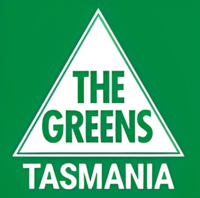History
The party's history can be traced back to the formation of the United Tasmania Group (UTG) (the first established 'Green' party in the world), which first ran candidates in the 1972 election. Many people involved in that group went on to form the Tasmanian Greens. Bob Brown stood as an Australian Senate candidate for UTG in 1975.
1980s
In the 1982 state election, Bob Brown stood unsuccessfully as an independent in the Denison electorate. In December of that year, Norm Sanders—a sitting member for the Australian Democrats—stood down from state parliament to contest the Senate in a Federal election. A countback of votes followed and Bob Brown was elected to the vacancy, commencing his term in January 1983. The two had much in common—both having been directors of the Tasmanian Wilderness Society—Norm Sanders being considered to be Australia's first elected "green" member of parliament.
Immediately prior to taking the seat, Bob Brown had spent 19 days in Risdon Prison for obstructing workers at the Franklin River dam site. He took his seat on the day of his release. He was re-elected in the 1986 election along with Gerry Bates in the Franklin electorate.
In the 1989 state election a total of 5 Greens—Christine Milne, Lance Armstrong, Di Hollister, Gerry Bates and Bob Brown—were elected after a community backlash against a proposed paper pulp mill at Wesley Vale near Devonport. At the time of the election they were known simply as The Independents. In December 1991 they changed their name to The Green Independents. They held the balance of power in the government for three years, keeping Michael Field's minority Labor Party government in power after signing an agreement known as the Labor–Green Accord. The February 1992 election saw all five sitting Greens re-elected but with a majority Liberal government in power.
Greens supporter Neville Curtis started the magazine Daily Planet in 1989, [3] which later became the official magazine of the Green Independents.
1990s
During 1990-1991 Brown advocated for a merger of the Green Independents with the Australian Democrats to form the "Green Democrats", as opposed to confederating with other Green Parties and forming the Australian Greens. [4] However, following a change in leadership in the Democrats, this plan could not continue and the Independents aligned themselves towards a unified Green Party. [4]
In August 1992 the Green Independents moved to officially form the Tasmanian Greens.
In 1993 Bob Brown stood down to contest the lower house seat of Denison in the federal election and Peg Putt took his seat on a recount. Christine Milne became leader. In May 1995 Gerry Bates resigned and his seat was taken by Mike Foley.
At the 1996 election, four Greens were returned (Lance Armstrong lost his seat in Bass) and they again held the balance of power, this time with a Liberal government.
After seven years of minority governments, the Labor and Liberal parties passed a bill reducing the number of Lower House seats, thus increasing the quota of votes needed under Tasmania's Hare Clark voting system from 12.5% to 16.67%. In 2011, Labor MP David Llewellyn confirmed to ABC Radio that the two major parties had "conspired" to reduce the number of seats in the House specifically to increase the quota for minor parties such as the Greens: "I could admit now that being part of the government back in 1998 or 1997 in conspiring, suppose that's not the best of words but that's what it was, between the Liberal Party and the Labor Party to reduce the size of Parliament on the basis that it would take more percentage for minor parties to actually win a seat." [5]
The 1998 election returned a majority Labor government, as well as a sole Green member—Peg Putt—who had little chance of exercising any influence, but would offer bills into Parliament knowing they would in all likelihood be voted against by both Liberal and Labor parties.
2000s
The 2002 election saw a major resurgence of their popularity, with the party winning 4 seats, and outpolling the Liberal party in the Hobart based seat of Denison. The swing was primarily against the Liberal Party, while the Labor party continued in the majority. The statewide 18.2% vote in 2002 was the highest vote recorded for a Green party at a state or national level anywhere in the world.
At the 2004 federal election, former Tasmanian Greens leader Christine Milne and WA's Rachel Siewert joined Bob Brown and NSW's Kerry Nettle in the Senate, doubling the Green representation.
On 23 July 2005 the Greens celebrated 33.3 years of political activity and achievements, with a large party entitled "33-and-a-third – Now we're Long Playing!"
The 2006 election saw a 1.5% swing against the Greens but all four sitting members were returned. In the lead up to this election Tasmanians for a Better Future organised a campaign against minority government suggesting it was a risky outcome for commerce and industry. [6]
Peg Putt resigned from the House of Assembly on 7 July 2008, and was replaced as party leader by Nick McKim. Cassy O'Connor was elected as her replacement in Denison after a recount of votes.
2010s
During the 2010 Tasmanian state election, the Tasmanian Greens secured a swing of 5% for a total of 21.6% of the primary vote, picking up a seat in Braddon and securing the balance of power in parliament, with the Tasmanian Greens members of the Tasmanian House of Assembly being Cassy O'Connor, Nick McKim, Kim Booth, Tim Morris and Paul O'Halloran.
On 16 January 2014, Premier Lara Giddings announced that a power sharing arrangement with the Tasmanian Greens was over. [7]
At the 2014 Tasmanian state elections there was a 7.8% swing away from the Greens with the party losing two of its five seats. [8] [9] The re-elected Greens leader Nick McKim said the swing against the Greens was due to electoral support for the conservatives and the "tarnish" of the Greens association with the previous Labor government. [10] Subsequently, Kim Booth was appointed as party leader, [11] however he resigned as leader and from the Tasmanian Parliament on 20 May 2015. [12] Cassy O'Connor was elected to replace him on 11 June 2015. [13]
In mid 2015, with the resignations of Kim Booth and Nick Mckim and being replaced by Andrea Dawkins [14] and Rosalie Woodruff [15] respectively, the Tasmania Greens was entirely made up of female representatives in the Tasmanian Parliament, until the election of Vica Bayley in 2023.
2020s
On 13 July 2023, Cassy O'Connor announced her resignation from her House of Assembly seat of Clark, and as Tasmanian Greens Leader. O'Connor also announced she would seek preselection to contest the seat of Hobart in the Tasmanian Legislative Council in 2024. Rosalie Woodruff was confirmed to replace O'Connor as leader of the party following the election of Vica Bayley to the seat of Clark. [16]
At the 2024 Tasmanian Election, the Greens received 13.9% of the primary vote with a positive swing of 1.5% towards the party. The party increased its representation from two seats to five, electing members in the divisions of Lyons and Bass, in addition to re-electing party Leader Rosalie Woodruff in Franklin, and Deputy Leader Vica Bayley in Clark. The party also picked up a second seat in Clark for the first time. [2]

The Australian Greens, commonly referred to simply as the Greens, are a confederation of green state and territory political parties in Australia. As of the 2022 federal election, the Greens are the third largest political party in Australia by vote and the fourth-largest by elected representation. The leader of the party is Adam Bandt, with Mehreen Faruqi serving as deputy leader. Larissa Waters currently holds the role of Senate leader.
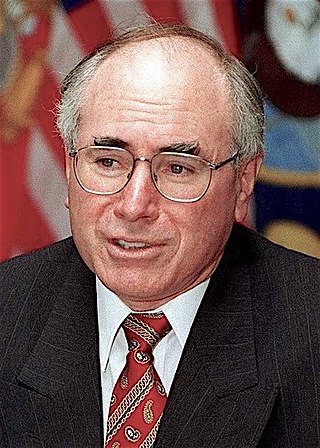
The 1996 Australian federal election was held to determine the members of the 38th Parliament of Australia. It was held on 2 March 1996. All 148 seats of the House of Representatives and 40 seats of the 76-seat Senate were up for election. The centre-right Liberal/National Coalition led by Opposition Leader John Howard of the Liberal Party and coalition partner Tim Fischer of the National Party defeated the incumbent centre-left Australian Labor Party government led by Prime Minister Paul Keating in a landslide victory. The Coalition won 94 seats in the House of Representatives, which is the largest number of seats held by a federal government to date, and only the second time a party had won over 90 seats at a federal election.

Christine Anne Milne is an Australian politician who served as a Senator for Tasmania. She was the leader of the parliamentary caucus of the Australian Greens from 2012 to 2015. Milne stepped down as leader on 6 May 2015, replaced by Richard Di Natale.
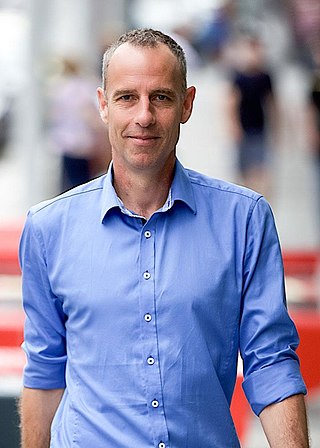
Nicholas James McKim is an Australian politician, currently a member of the Australian Senate representing Tasmania. He was previously a Tasmanian Greens member of the Tasmanian House of Assembly elected at the 2002 election, representing the Franklin electorate from 2002 to 2015, and led the party from 2008 until 2014. On 21 April 2010, he became the first member of the Greens in any Australian ministry. From February 2020 until June 2022, he served as co-deputy leader of the Australian Greens.
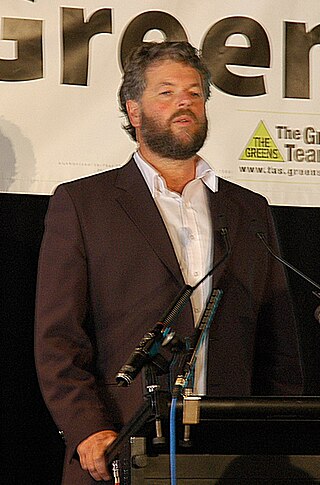
Kim Dion Booth is a former Australian politician. He was the leader of the Tasmanian Greens from April 2014 to May 2015, and represented the Division of Bass in the Tasmanian House of Assembly.

A general election for the Tasmanian House of Assembly was held on Saturday 20 July 2002. The Labor government led by Premier Jim Bacon was won a second term against the Liberal Party Opposition headed by Opposition Leader Bob Cheek in a landslide. The election was marked by a strong swing to both the Labor Party and the Tasmanian Greens at the expense of the Liberals, with Cheek losing his own seat.

An election for the House of Assembly was held in the Australian state of Tasmania on 18 March 2006, the same day as the South Australian elections. The Labor Party led by Premier Paul Lennon, won a third successive majority government term in office, despite predictions the election would result in a minority government. Although there was a small swing against Labor, they finished with 14 seats, and there were no changes in the party composition of the assembly. The Liberal Party led by Rene Hidding gained a small swing and finished with seven seats. The Tasmanian Greens led by Peg Putt suffered a small swing and finished with four seats; meaning no change in seat representation since the last election. Had the Greens lost one of their four seats, they would have lost their status as a major party and would lose financial resources, offices and support staff.

The 1989 Tasmanian state election was held on 13 May 1989 in the Australian state of Tasmania to elect 35 members of the Tasmanian House of Assembly. The election used the Hare-Clark proportional representation system — seven members were elected from each of five electorates. The quota required for election was 12.5% in each division.

The 1992 Tasmanian state election was held on 1 February 1992 in the Australian state of Tasmania to elect 35 members of the Tasmanian House of Assembly. The election used the Hare-Clark proportional representation system — seven members were elected from each of five electorates. The quota required for election was 12.5% in each division.
The Labor–Green Accord was a 1989 political agreement between the Labor Party and the Tasmanian Greens to form government in the Australian state of Tasmania after the 1989 general election had resulted in a hung parliament.

Cassandra Stanwell O'Connor is an Australian politician, who was a Tasmanian Greens member of the Tasmanian House of Assembly from 2008 to 2023, representing the electorate of Denison which was renamed to Clark in September 2018.

The 2010 Tasmanian state election was held on 20 March 2010 to elect members to the Tasmanian House of Assembly. The 12-year incumbent Labor government, led by Premier of Tasmania David Bartlett, won a fourth consecutive term against the Liberal opposition, led by Will Hodgman, after Labor formed a minority government with the support of the Greens.

The 2014 Tasmanian state election was held on 15 March 2014 to elect all 25 members to the House of Assembly. The 16-year incumbent Labor government, led by the Premier of Tasmania Lara Giddings, sought to win a fifth consecutive term in government, but was defeated by the Liberal opposition, led by Opposition Leader Will Hodgman, in a landslide victory. Also contesting the election was the Greens led by Nick McKim. The Palmer United Party made a significant effort in the election.

The 2018 Tasmanian state election was held on 3 March 2018 to elect all 25 members of the Tasmanian House of Assembly.
This is a list of members of the Tasmanian House of Assembly, elected at the 2014 state election.
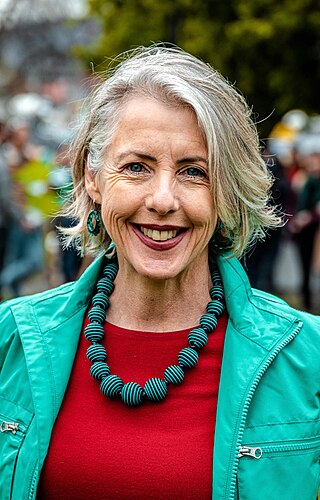
Rosalie Ellen Woodruff is an Australian politician and current leader of the Tasmanian Greens. She has represented Franklin in the Tasmanian House of Assembly since 17 August 2015, when she was elected in a countback to replace Nick McKim.

The 2021 Tasmanian state election was held on 1 May 2021 to elect all 25 members to the Tasmanian House of Assembly.
The Australian Greens have had four federal leadership elections in their history. On each occasion, a single candidate was elected unopposed.
The history of the Australian Greens has its origins in the green parties founded in the 1980s in each of the states of Australia.

Vica Bayley is an Australian politician. He is a Greens member of the Tasmanian House of Assembly, representing the electorate of Clark since 2023 when he was elected in a countback of votes to replace Cassy O'Connor. Since 2024, Bayley has served as Deputy Greens Leader.
